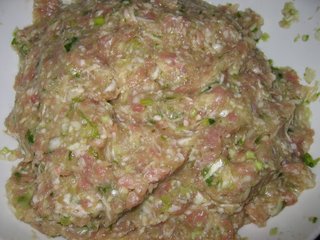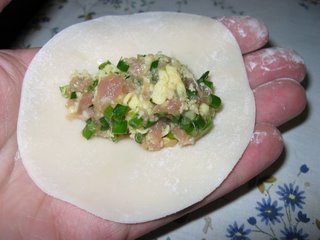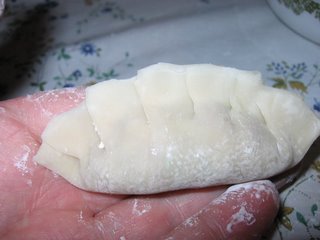I was talking to some of the Asian ladies at work in the lunchroom (I say Asian now, as the Chinese ladies have now been joined by a woman from Thailand) about my brother-in-law cooking for me when he is visiting. They know that he is from the North, and they all joined in that he should know how to make Jiaozi, or dumplings. I said that I would ask, knowing he could cook a lot of things, but maybe not that. My sister later told me that it is a stereotype that Northerners know how to cook dumplings. Nevertheless, his mother does know, and she had taught him a little of it, so we determined to try to make them on Sunday. First we gathered the ingredients, some scallions, some ground pork, and some chives. We would make two kinds of jiaozi, one with ground pork, shredded cabbage and scallions, and one with ground pork, chives and scrambled eggs. The latter of the two is my brother-in-law's favourite, and too, it tasted the better of the two when we ate them for lunch. We decide too, for the sake of expediency, to use pre-made dumpling wrappers, instead of creating the dough and rolling it out, of course, it would have tasted better, but it tasted pretty excellent otherwise. These are two examples of fillings, you can pretty much put anything in there, even making them fully vegetarian. As for quantities, we used about 400 g of pork for each filling, a half head of white cabbage, 10-12 long chives, 6-8 scallions and 4 eggs.
Firstly, shred the cabbage into very small pieces, we used a food processor to do so, but traditionally it is done with a knife, over a long period of time. Even the pork is traditionally minced by hand with a knife. Slice the scallions into small pieces as well. Then mix all ingredients with your hands, adding a little soya sauce, until all ingredients are combined well. There are some things that work better when mixed with your hands, this is one of them. Let rest for a few minutes, then add a little sesame oil and mix again, before assembling the dumplings.

For the other one, scramble the eggs, frying them in a little oil. Let cool for 10-15 minutes, so that they are not hot and cook the meat when added. Slice the chives into very small chunks. Then mix the cooled eggs, ground pork, chives and a little soya sauce with your hands, until all ingredients are combined well. Like the other, let the filling rest for a few minutes, then add a little sesame oil and mix again, before assembling the dumplings.

Here my sister and I work making the dumplings.

To create the dumpling, put a little bit of filling in the center of the wrapper.

Then moisten the edges of the wrapper with a finger dipped in water. Fold over the wrapper, lining up the edges to make a half circle. The water will bind with the slight flour on the wrapper to seal the edge.

To make it seal firmly, especially the cabbage one, which tends to be more watery, and more prone to breakage when boiling, you need to crimp the edges. Fold over a small section of the outer edge and press together firmly. Repeat a number of times. When I first started, I only crimped four times, later I got better and crimped around seven times. It's a little difficult to explain, and a little difficult to master, I agree, but the picture should give you a better idea.

Once the dumplings are done, let them rest for a moment. Bring some water to boil.

Add the dumplings, and bring to the boil. When it does boil, add some cold water, then bring to the boil again. Repeat one more time. The dumplings are finished when they all are risen to the top, and they begin to swell, with air.

We enjoyed them with a garlic sauce, made by mincing a whole garlic bulb, adding to the minced garlic some Chinese vinegar, a little soya sauce and sesame oil, and a little salt. Drizzle over the cooked dumplings and enjoy. Or, you can just drizzle them with vinegar, any kind. I use apple cider vinegar to good effect.
No comments:
Post a Comment